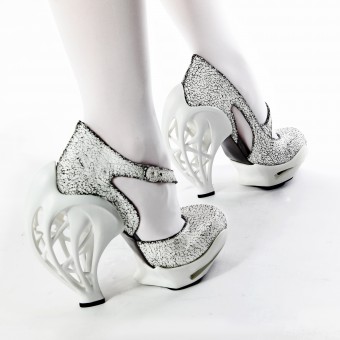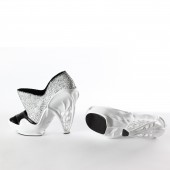Breaking The 3-D Mould The 3D printed shoes. by Zoe Jia-Yu Dai |
Home > Winners > #41725 |
 |
|
||||
| DESIGN DETAILS | |||||
| DESIGN NAME: Breaking The 3-D Mould PRIMARY FUNCTION: The 3D printed shoes. INSPIRATION: The design inspirations for this collection came from natural structures, such as shell, fossil and bone, which are used to support or protect animals. Bone is a crucial part of a creature’s body, supporting their weight in a similar way to a shoe supporting the weight of the wearer. Another inspiration was organic shapes already used in art, for example, the Bone Chair created by Joris Laarman and the Sagrada Familia designed by Antoni Gaudi. Further inspiration derived from natural textures. UNIQUE PROPERTIES / PROJECT DESCRIPTION: My project came from a desire to look at ways to change the process of footwear manufacture. It was clear that 3-D printing could not only achieve this, but would also allow a large amount of flexibility in the design stage, as well as allowing me to push the limits of design structures. Therefore, I would like this collection to be part of the further development of the use of 3-D printing in design and manufacturing processes, and in particular in relation to the production of footwear. OPERATION / FLOW / INTERACTION: - PROJECT DURATION AND LOCATION: The project started in June of 2014 in London and finished in December of 2014 in London. |
PRODUCTION / REALIZATION TECHNOLOGY: My shoe collection combines the modern technology (3-D Printing) with a high level of craftsmanship, using traditional shoe making techniques. Materials are PLA, ABS , Nylon , leathers. SPECIFICATIONS / TECHNICAL PROPERTIES: The wearable shoes are size 37. TAGS: 3dprinting, 3dprinted, fashion, footwear , shoes, heels, technology, creative, innovative, organic RESEARCH ABSTRACT: “3-D printing has the potential to revolutionise the way that we make almost everything,” (Barack Obama, 2013). The current footwear industry relies heavily on techniques developed many decades ago, and most modern production is still based on these archaic methods. Even high-end shoes tend to use these traditional methods, and some of the most expensive shoes available today are hand-made, using methods that have been used for centuries. So where will the next revolution in footwear manufacturing come from? The answer to this question could be 3-D printing. Recent developments in the technology of 3-D printing have seen costs reduced significantly, and an ever-widening availability of materials, colours, and other customizable options. This has, potentially, far-reaching consequences for the footwear industry. As Gemma Williams, Curator of Fashion Space Gallery at the London College of Art said: "Shoe-makers could create footwear in a living room, as long as they have a 3D-Printer,” (Gordon, B., 2014). This project focused on ways that footwear manufacturing can change as a result of 3-D printing technology, including ways in which 3-D printed components can be incorporated into shoes, parts of the production process that can be 3-D printed, as well as how cutting-edge material and process developments in 3-D printing can affect such designs. As 3-D printing is inherently customizable, and much of the technology is cutting-edge, this project also focused on custom-made shoes with small-scale production. This allowed a greater degree of flexibility with price and design, and allowed a greater range of possibilities to be explored. CHALLENGE: I think the biggest hardest part of the design activity was how to intelligently apply this advanced technology to my shoe design and combine this technology with traditional shoe making techniques, rather than 3-D printing the whole shoe. Shoe making is highly skilled and needs to be precise in areas such as structure and proportion. The other most difficult part was creating a complex heel structure that could support a person’s weight, whilst simultaneously considering the overall aesthetics of the shoes. ADDED DATE: 2015-06-25 09:03:45 TEAM MEMBERS (1) : Zoe Jia-Yu Dai. IMAGE CREDITS: Main Image #1: Photographer Hisashi Mibuchi/ Creator: Zoe Jia-Yu Dai 2014. Optional Image #1: Photographer Hisashi Mibuchi/ Creator Zoe Jia-Yu Dai 2014. Optional Image #2 : Photographer Hisashi Mibuchi/ Creator: Zoe Jia-Yu Dai 2014. Optional Image #3 : Photographer Hisashi Mibuchi/ Creator: Zoe Jia-Yu Dai 2014. Optional Image #4 : Photographer Hisashi Mibuchi/ Creator: Zoe Jia-Yu Dai 2014. |
||||
| Visit the following page to learn more: http://www.zoedai.com | |||||
| AWARD DETAILS | |
 |
Breaking The 3-D Mould The 3d Printed Shoes. by Zoe Jia-Yu Dai is Winner in 3D Printed Forms and Products Design Category, 2015 - 2016.· Press Members: Login or Register to request an exclusive interview with Zoe Jia-Yu Dai. · Click here to register inorder to view the profile and other works by Zoe Jia-Yu Dai. |
| SOCIAL |
| + Add to Likes / Favorites | Send to My Email | Comment | Testimonials | View Press-Release | Press Kit |







